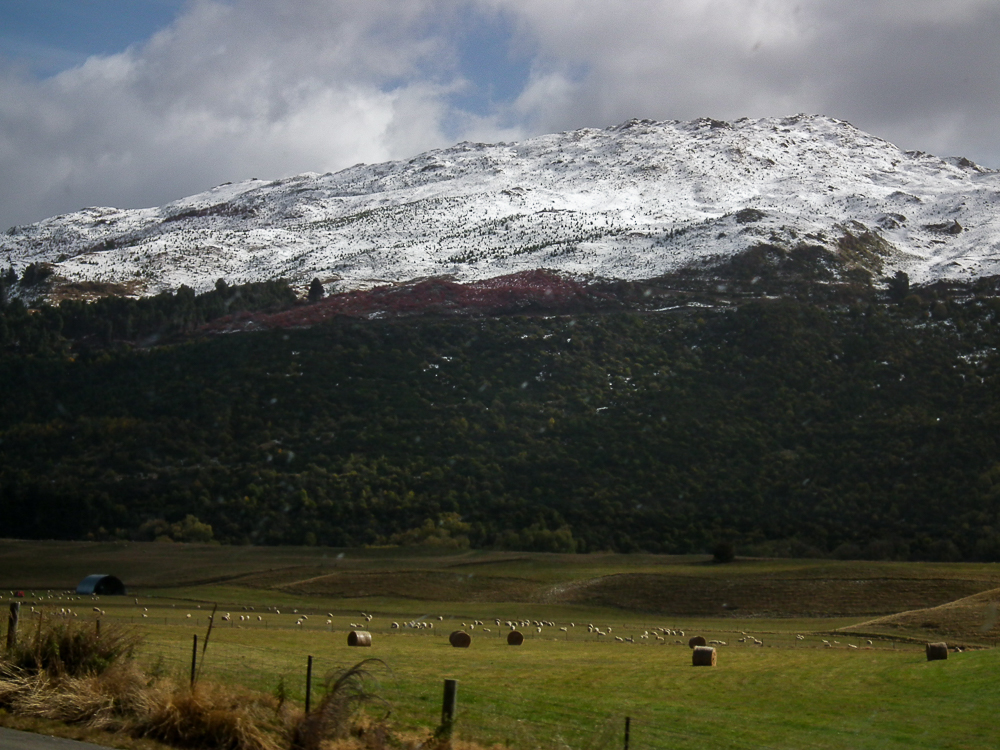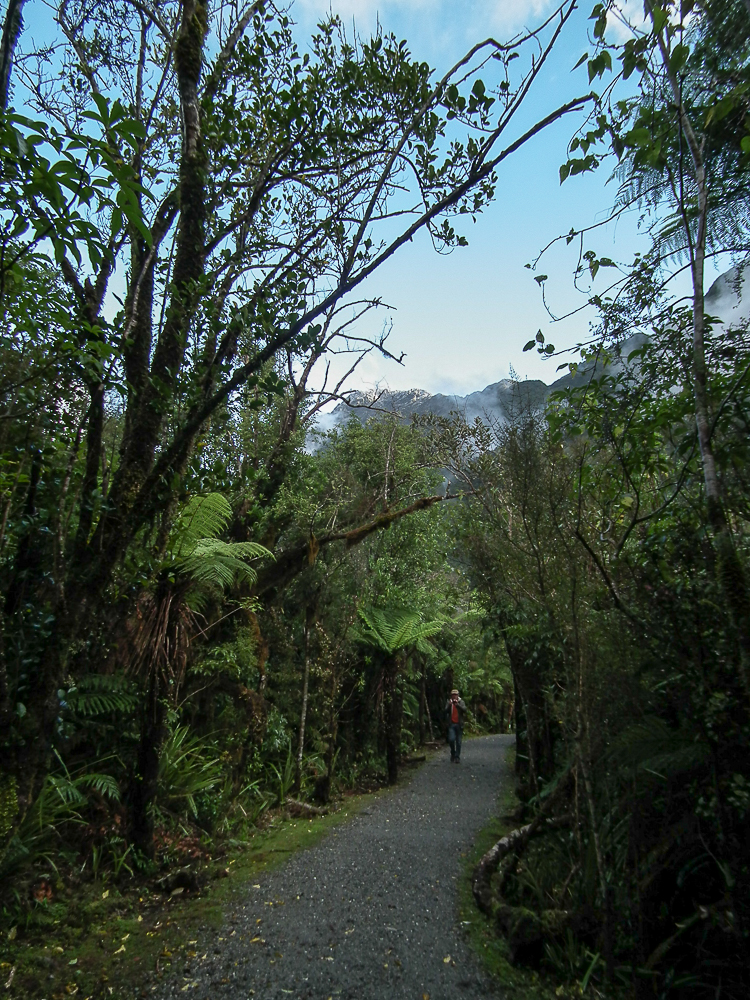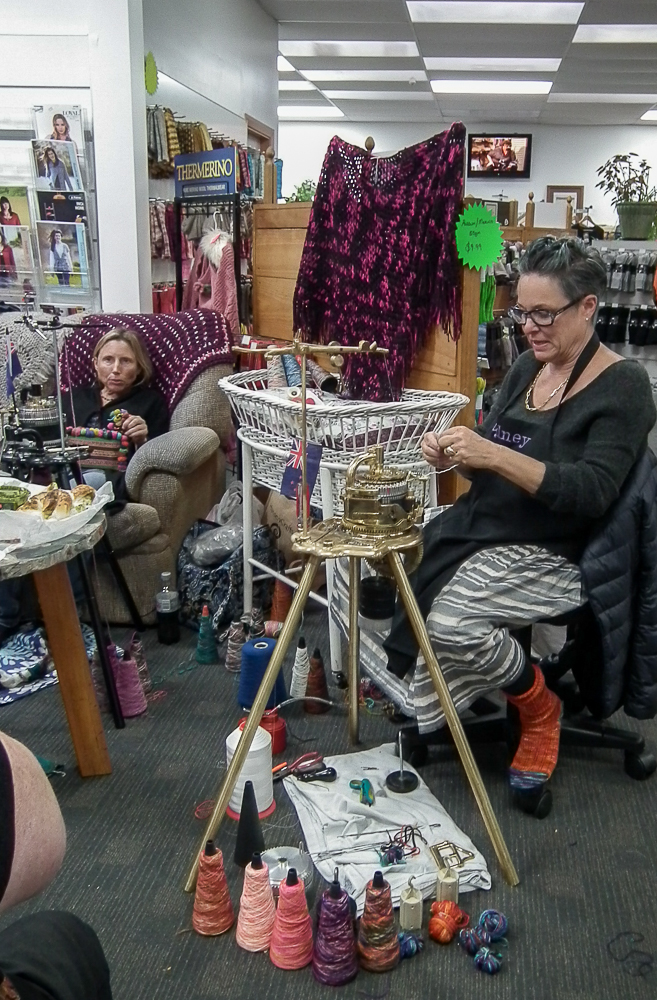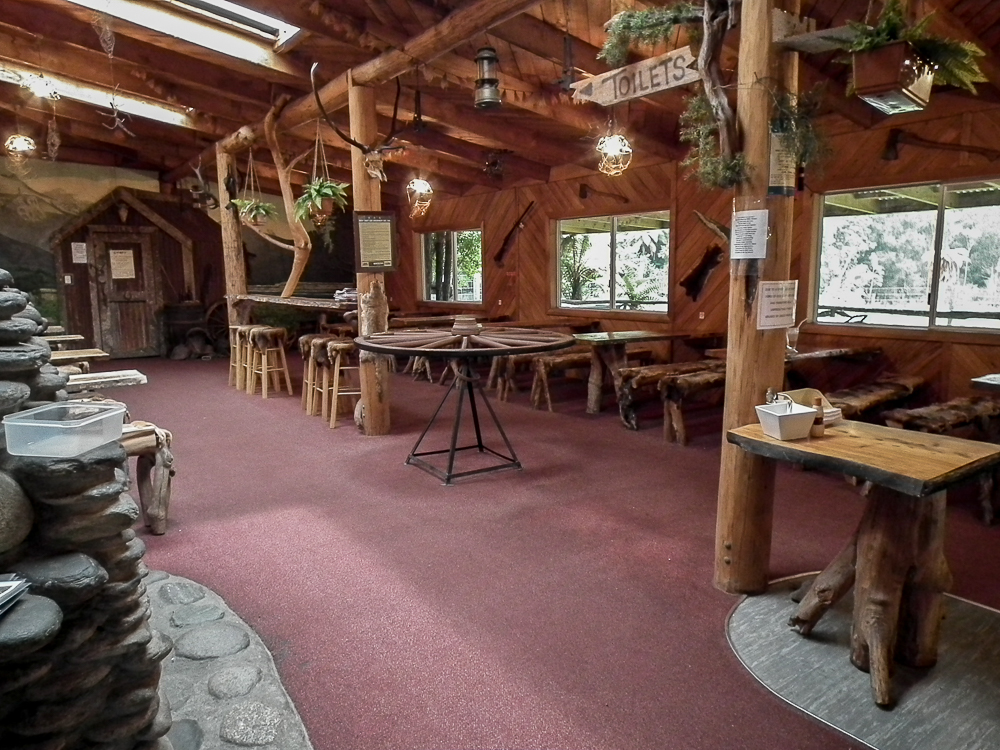In the spring of 2016, Henderson Productions took an extended do-it-yourself driving tour of New Zealand. We’re excerpting portions of our trip in this blog. Both a book and plan-it-yourself itinerary are available for sale in our Shop on www.focusbyhenderson.com.

It was the giant fly hanging on the roofline that caused us to slam on the brakes a half mile later and turn around. Apparently, it works often for The Bushman Museum. Sometimes ya just gotta go with the quirky. We were 7 hours into our day and it struck us as a perfect addition to the wild ride we’d discovered.

We’d gotten up fairly early and left the downtown Christchurch district after a maze of entertaining one- way mis-directions. As we headed straight west, we moved from the centre to suburbs to major-league horse country then sheep and then cows and back to sheep as the terrain changed to scrubby hills. It was absolutely gorgeous with bright blue skies and green fields. We stopped at “a scenic panoramic viewpoint” established by the Christchurch Lions and busted a gut laughing at the platform view being bisected by a line of telephone poles. Exactly in the center all the way to the mountains. Hysterical.
We carried on westward and slammed on the brakes for the Sheffield’s Famous Pie Shop. I mean….who wouldn’t right? Bought a lovely apple shortbread dessert for later as it was a bit early in the morning. The place was packed. While we were there the tourist scenic railway train came buzzing by. Bet they missed the scenic panorama, too.
It was pretty skies and didn’t hurt to have red poppies waving along the side of the roadside. As we approached the mountains there were more and more signs for campgrounds and youth hostels and B&Bs. We stopped at Castle Hill where a bunch of random limestone rocks were perched looking for all the world like intentional placement but were assured by the signage it was random. Still, very picturesque and a nice place for a stretch.
As we approached Arthurs Pass, the highest crossing of the Southern Alps, a light rain began. We stopped into the Arthur’s General Store for a bathroom break and get a cup of coffee. Sorta hoped the rain was going to stop. It did on and off for the next 3 hours. We discovered some interesting goods in this prime starting point for hikers and rock climbers and high-altitude trekkers. Dehydrated venison risotto and Moroccan lamb stew for backpacks, a whole case of meat pies and pasties (British handheld warm sandwiches). Had a good laugh over the One Square Meal packet with exactly one third your daily requirements for everything including vitamins, calories, fiber, minerals, even amino acids. International patent pending in case you’re planning to rip off their name.

We came around the corner up along the pass to an odd head sticking out of the treetops. Pulled into the lot and found a quirky statue sitting on a little hill surrounded by ferns and ancient growths of all sorts. It was s tribute to the now extinct giant flightless bird that has become a symbol for the uniqueness of the country. Looked like an ostrich on steroids and with the neck fully extended could easily be seen above the trees as a tyranosauros rex. That was sort of a good indication of the day – we felt like we were on Rt 66 with fun, local color around every bend. We also felt like the guidebooks were all accurate in describing multiple ecological zones along the trip – we reckon six completely different ecosystems were encountered. The area for horse country was paddocks with manicured grazing. The tussock covered, dry eastern slopes of the range were perfect for sheep and the occasional goats. Boulders gave way to pine/Cyprus forests which turned very quickly around one corner to beech trees. Barely over the pass and it immediately switched to what almost looked like redwoods – very tall, strong and old trees. Might have been cedars but it was dark green and the thicket was much more impenetrable than the eastern upper slopes. As we descended – and that was much quicker than the ascent on the other side – it became all about huge ferns of varying shades of green. Rick was fascinated with the fern trees which stood over 6 foot tall. They looked like palm trees with narrow trunks and then an explosion of 5-foot-long fern fronds from the top splayed out like a ponytail on top of a young girl’s head.
So even though it rained down the whole western side, the dense cover didn’t mind. And our first view of the Tasman Sea took us by surprise in the midst of more sheep farmland. Our expectations are so shaped by what we’ve seen before aren’t they? We, in America, know there to be a gradual leveling out to sea level with salt air affecting the flora and fauna and making changes to soil content. Not so here on the west coast of the South Island. The guidebooks say it’s one of only 2 places in the world (the other being Argentina) where glacial mountains come within 200 feet of sea level. And the prevailing Antarctic winds keep the rainforest well fed which must greatly diminish the salt in the soil. It is very fertile along the narrow strip between the mountains and the sea.
We had travelled about 3 hours to the top and then began the descent to the Tasman Sea. We made our way through a series of one-way bridges and zig zagged over riverbeds to the coast, deciding on lunch in Hokitika. And as we parked, it stopped raining allowing us to wander a bit. This is one hippy sort of town. We had already decided the journey down from the mountains reminded us a lot of Rick’s Northern California neck of the woods. And Hokitika definitely struck us like Ft Bragg complete with a windy beach and a bunch of hippy women having the first international machine sock festival with the fine merino wool available in the region.
By then, at close to 2 PM, a light rain escorted us out of town and straight south along the coast road with striking bright green farms running right up to the turquoise Tasman Sea. Stunning. But still raining.
And that brings us to Pukuhara – in the middle of a long line of fern and spruce forests – you’re minding your own business and a giant fly virtually drags you in. It’s the Bushman Museum where the issue du jour is “NO 1080” which is apparently a pesticide air dropped into the tropical rainforest by the government in an effort to eradicate possums because they carry TB. Another side effect is it kills rats and all small mammals. It’s sodium flouroascetate and a contentious issue between the government who considers it safe vs the hunters – like The Bushman – who want to protect their livelihood. Now, our hosts at The Bushman Museum have clearly made a living from such possums by selling fine fur and tanned skin goods like jackets and gloves but also have self-stick possum fur nipple covers and willy warmers. Their café offers possum jerky and stew and possum pies in a rustic cabin. We didn’t bother to purchase the $4 “museum” admission fee as we really didn’t need it. We could have purchased The Bushman’s book for $39 but – I mean, who needs a hardback to lug around for 2 weeks?
What we DID gain was a lesson in how to open a beer. It’s Sunday so we hadn’t found a place open to purchase a church key. So while we were in a touristy place, when they asked if they could help us with anything, Rick said “Yeah. I’ve got a six pack but no way to open them. Do you have a bottle opener?” “Why would you need one when we can show you how to open the bottle without it?” OK. And off he goes to get a bottle from the car.
“OK. First you pull out your kniaife. You do have a knaife dontcha?” “Well, no. I normally carry one, but we came on a plane and they don’t allow them.” “Well, what DO you hev? Tools? A metal ruler? Anything in your caa?” “Well, no. It’s a rental car.” “Well then, you hev keys dontcha?” “Sure” “Let me have ‘em.” And he flipped open the beer. Wouldn’t even take the beer. Actually, that’s not correct. I said, “well we should share the beer with you” She said, “Naow, it’s a bit early for us to be havin beah.” But Rick told me later he had quietly muttered “It’s not too ahrly for me.” Too late.
Some good laughs as we left heading back out on the rainy, ferny drive. We drove through the old mining village of Ross and tracked along the coast for another hour or so wishing the mist would lift and we could see some of those gorgeous mountains. And just as we were pulling into Franz Josef around 4 PM, blue sky appeared over the mountains. Mt. Cook and Mt Tasman were tantalizingly tempting us to keep coming.
And I had been plotting for a rainy nap! Checked in quickly and just as quickly opted to drive up to the glacier parking lot and see how it looks. Rewarded. It was getting close to sunset so we took the short walk toward the reflecting lake. Just great. Fun to be walking. Great pics. And just as quickly as it was visible – disappeared.

And we resolved to take an hour and a half nap, then up for dinner and an evening trail to see the glowworms and NOT go to bed til at least 11. We’re gonna kick this jetlag.
What’s your experience in New Zealand? We’d love to hear your
thoughts and suggestions on Facebook at “suehendersonphotography















